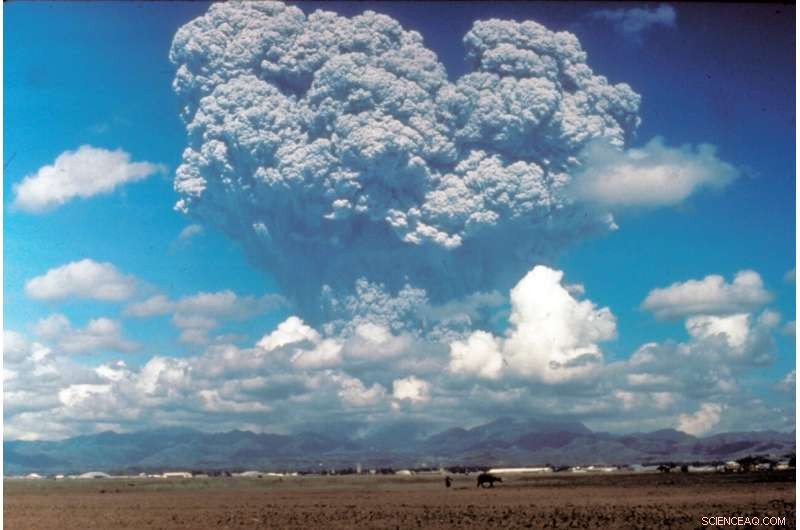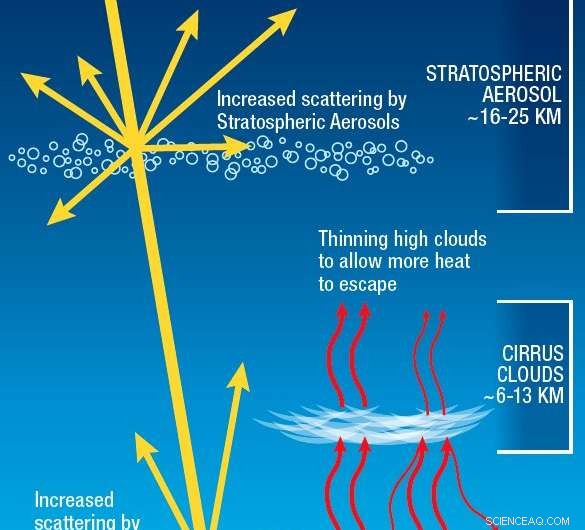
Lorsque le mont Pinatubo est entré en éruption en 1991, il a éjecté 20 millions de tonnes de dioxyde de soufre dans l'atmosphère. Au cours des mois qui ont suivi l'éruption, les aérosols ont formé une couche globale de brume d'acide sulfurique. Les températures mondiales ont chuté d'environ 0,4 °C entre 1991 et 1993. C'est une forme naturelle de géo-ingénierie solaire que les humains pourraient essayer d'imiter pour refroidir la planète. Crédit :Dave Harlow, Commission géologique des États-Unis/Wikimedia Commons/Domaine public
Cela ressemble à quelque chose d'un mauvais film de science-fiction - bloquant artificiellement la lumière du soleil pour empêcher le réchauffement climatique de surchauffer la Terre. Néanmoins, un petit groupe de chercheurs étudie l'option - de sorte que si l'humanité a besoin de l'utiliser, ce sera une décision éclairée.
Le dernier rapport du Groupe d'experts intergouvernemental sur l'évolution du climat (GIEC), sortie début août, clairement que l'humanité doit prendre des mesures immédiates pour freiner le réchauffement climatique. On espère que les pourparlers internationaux sur le climat à Glasgow en novembre pourront enfin aboutir à des limites d'émissions de gaz à effet de serre suffisamment strictes pour faire la différence.
Mais juste au cas où, un groupe international de chercheurs, dont Helene Muri de NTNU, a étudié une technologie appelée géo-ingénierie solaire comme action de dernier recours.
La géo-ingénierie solaire est exactement ce que cela ressemble, où diverses technologies sont utilisées pour bloquer la lumière du soleil et refroidir la Terre. Typiquement, trois approches principales, dont aucune n'est actuellement technologiquement prête, sont étudiées pour leur capacité à bloquer la lumière du soleil et à abaisser les températures du sol. (Voir encadré)
Muri, chercheur senior au programme d'écologie industrielle de l'université, a passé la dernière décennie à examiner comment la géo-ingénierie solaire pourrait fonctionner ou non.
En juin, elle et ses collègues des États-Unis, La Chine et le Royaume-Uni ont publié un article en Nourriture naturelle qui a utilisé des modèles informatiques pour évaluer les effets potentiels de la géo-ingénierie solaire sur l'agriculture dans un monde à fortes émissions. Leurs résultats ont suscité une couverture médiatique internationale, car ils ont découvert que la géo-ingénierie solaire dans ces scénarios pourrait en fait avoir un effet positif sur la croissance des cultures en raison d'une humidité plus élevée.
D'autres études qui ont utilisé des modèles plus simples ont trouvé soit un effet limité, soit des pertes pour les cultures pluviales, car il pourrait y avoir moins de précipitations avec les températures plus basses qui accompagnent la géo-ingénierie solaire, selon la façon dont la technologie est utilisée pour refroidir la Terre.
Maintenant, alors que le monde se prépare à débattre des limites du CO
Pansement ou garrot ?
Toute discussion sur la géo-ingénierie solaire doit reconnaître que c'est loin d'être une solution parfaite, dit Muri.
"La géo-ingénierie solaire, peu importe à quel point nous le faisons bien, ne compensera jamais parfaitement les effets du changement climatique, " elle a dit.
Le problème est que la géo-ingénierie solaire peut refroidir la Terre, mais ne se débarrasse pas de l'excès de dioxyde de carbone et d'autres substances piégeant la chaleur dans l'atmosphère. Et le dioxyde de carbone fait plus que simplement réchauffer la Terre.
Il fertilise les plantes - ce qui pourrait être une bonne chose - mais comme une grande partie se dissout dans l'eau de mer, cela rend les océans plus acides.
"Il y aura toujours des choses que vous ne pourrez pas résoudre avec la géo-ingénierie solaire, en particulier l'acidification des océans, " dit-elle. " Un océan plus acide affecte tout dans les chaînes alimentaires de l'océan, y compris le dépérissement des récifs coralliens, ce qui est terrible pour l'écosystème dans son ensemble. Cela devient évident dès que vous commencez vraiment à le regarder. Il n'y a pas de solution miracle. Ce n'est pas la seule solution qui peut tout régler."
Muri dit que toute discussion sur la géo-ingénierie suppose également que le CO
Alain Robock, un chercheur sur le climat à l'Université Rutgers aux États-Unis qui est à la tête d'un projet de recherche coopératif international appelé GeoMIP, dont Muri fait partie, D'accord.
"Ce n'est pas une solution au réchauffement climatique à son meilleur. S'il a déjà été utilisé comme pansement - ou comme garrot - il ne résout pas le problème à la racine, " il a dit.
Beaucoup d'inconnues, mais encore faut-il savoir
Muri dit qu'il y a encore beaucoup de choses inconnues sur la géo-ingénierie solaire, en partie parce que la plupart des recherches sur le changement climatique sont axées sur des questions autres que la géo-ingénierie.
« Juste pour mettre le niveau de recherche en contexte, depuis cinq à dix ans, il y a eu environ 100 à 130 articles publiés par an sur la géo-ingénierie solaire, " a-t-elle dit. " Quand il s'agit de changement climatique, c'est plutôt 30, 000 articles par an sur cette période. L'important, c'est qu'il s'agit d'un montant très différent. Ce n'est qu'une minorité d'efforts et de financements consacrés à la recherche en géo-ingénierie solaire. »
À la fois, elle dit, les Académies nationales des sciences des États-Unis, Engineering and Medicine a publié un rapport complet sur la géo-ingénierie solaire qui a déclaré que l'urgence des risques posés par le changement climatique signifiait que "les États-Unis devraient poursuivre un programme de recherche pour la géo-ingénierie solaire - en coordination avec d'autres nations, soumis à la gouvernance, et parallèlement à un solide portefeuille de politiques d'atténuation et d'adaptation au changement climatique. » Le rapport recommandait un financement américain d'environ 100 à 200 millions de dollars au cours des cinq premières années.
Muri dit que l'objectif principal des chercheurs en climatologie doit rester sur le changement climatique lui-même, parce que la société a besoin de savoir quels en seront les effets, comment s'adapter, et comment atténuer ces effets. Néanmoins, elle dit, researchers do need to study solar geoengineering to see if it could be helpful as a stopgap measure while the world transitions away from fossil fuels.
"The question is if it could contribute to reduce some level of harm from climate change for a certain period, whilst we are trying to sort out both emissions of CO
Robock agrees.
His group at Rutgers University is "doing research to evaluate the risks of doing solar geoengineering versus the risks of not doing it. And that's the information that governments will need in the future to decide whether or not to ever implement it, " he said. "I spend millions of dollars of taxpayer money to do my research. And if I find a danger to society, it's my obligation to warn people about it."

Three main types of solar geoengineering that are now being studied. Credit:US National Academy of Science
A cooler Earth but potentially changed monsoons
Robock's group is looking at the benefits and risks of using stratospheric aerosols to cool the planet, which emulate a volcanic eruption.
"Benefit number one would be, if you could do it, you would reduce global warming, and many of its risks, " Robock said. "We know that if you could get the aerosols up there, it would work because it doesn't involve creating or affecting clouds in the troposphere, it's just putting a shield up there to reflect sunlight."
Researchers know that big volcanic eruptions, like the 1991 eruption of Mount Pinatubo, cooled the Earth. But these natural solar geoengineering experiments have also given them the ability to observe other pitfalls, Robock said.
"We know that there were other things that were not so good; (the eruption) destroyed ozone, " he said. "And you actually get a huge reduction of monsoon rainfall. We observed that after Mount Pinatubo."
Volcanic eruptions only cause the Earth to cool for a year or two, because the aerosols eventually dissipate. Cependant, if stratospheric aerosols were to be used as solar geoengineering to cool the Earth, their use could alter monsoon rainfall for a much longer period, which could result in famine, Robock said.
Some modeling has shown that solar geoengineering could in fact have less of an impact on monsoons than global warming, but nevertheless, the issue illustrates just how difficult making these predictions are.
Who decides?
Then there are issues such as insect-borne diseases, like malaria, Muri points out. How would solar geoengineering affect mosquito populations and the potential spread of malaria?
And what if a failure to cut CO
"There are still so many areas where we don't know enough, " elle a dit.
Finalement, there are areas that are far outside of what climate scientists who study the physical effects of climate change can predict. The biggest question is who decides what the temperature of the planet should be?
The political decision making surrounding solar geoengineering is daunting, if you consider the difficulty the nations of the world have already had in trying to agree to curb CO
"How would one deal with geoengineering in terms of geopolitics and governance?" Muri said. "We need to develop regulations. Who sets the thermostat and how would you go about agreeing on something like that?"
In a companion piece to Muri and her colleague's article on geoengineering and agriculture, Ben Kravitz, an assistant professor at Indiana University's Earth and Atmospheric Sciences Department, summed it up like this.
"Agriculture is one important piece in our understanding of the effects of climate engineering, " he wrote. "Gaining a better picture of the impacts of climate engineering requires looking at numerous effects in addition to food supply, including water security, geopolitics, and environmental justice…. It is important to figure out whether climate engineering would ultimately be more or less risky than climate change (and to whom)."
What is solar geoengineering?
Researchers are studying a number of engineering approaches as possible methods for cooling the planet. The three described here have been identified by a March report by the US National Academies of Sciences, Engineering and Medicine as meriting further study. The three approaches either rely on controlling the amount of sunlight reaching the Earth, or reducing the amount of heat trapped by the atmosphere.
Stratospheric aerosol injection
This technique requires injecting aerosol particles, like sulfates or pre-cursor gases, like sulfur dioxide, into the stratosphere, which is the layer of air 10 to 50 km above the Earth's surface. Most studies are looking at placing aerosols at about 20 km above the Earth, where the particles scatter and reflect solar radiation to cool the planet. This technique mimics what happens with large volcanic eruptions. When Mount Pinatubo erupted in 1991, it sprayed 15 to 20 megatons of sulfur dioxide into the atmosphere, which cooled the Earth by about 0.4 degrees Celsius for two years. Actuellement, cependant, there are no planes capable of flying into the stratosphere to do this.
Cirrus cloud thinning
This technique involves spraying chemicals into cirrus clouds, at about 6-13 km above the Earth's surface, to cause them to thin or disappear. The clouds trap heat, so thinning them or reducing them cools the planet by allowing heat to escape the atmosphere. The challenge for this technique is that cirrus clouds are in the region of the atmosphere where jets fly, which could make implementing this measure difficult.
Marine cloud brightening
This approach would add particles to low laying liquid clouds over the ocean to make them thicker and more reflective, which would cool the Earth, if it did not have side effects on other clouds. This mimics what happens now under certain conditions when ships spew pollution into the atmosphere. The effect only works for a few days, and sea salt could be sprayed up from the ocean to seed the clouds.